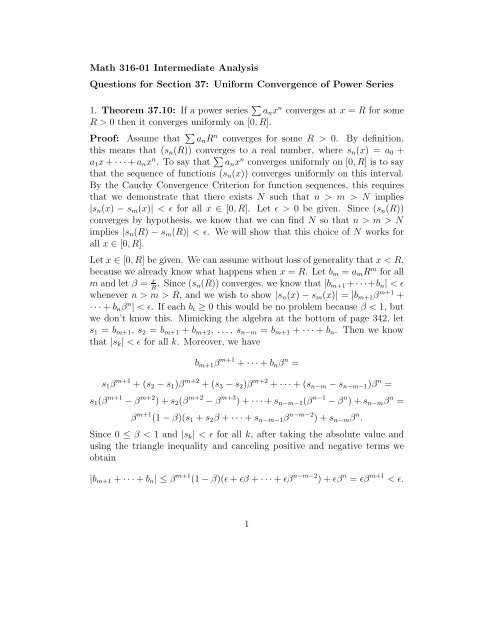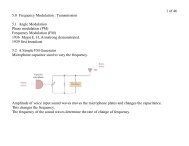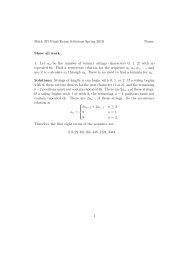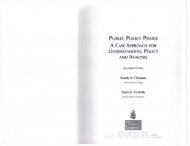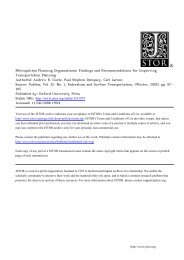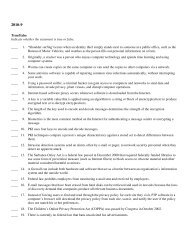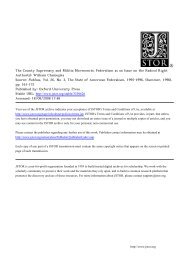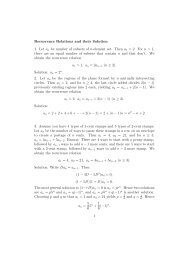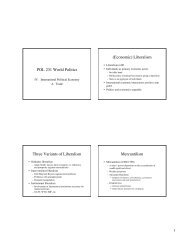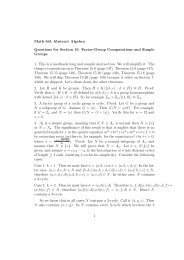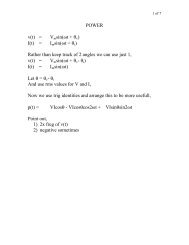Uniform Convergence of Power Series - MavDISK
Uniform Convergence of Power Series - MavDISK
Uniform Convergence of Power Series - MavDISK
Create successful ePaper yourself
Turn your PDF publications into a flip-book with our unique Google optimized e-Paper software.
Math 316-01 Intermediate Analysis<br />
Questions for Section 37: <strong>Uniform</strong> <strong>Convergence</strong> <strong>of</strong> <strong>Power</strong> <strong>Series</strong><br />
1. Theorem 37.10: If a power series anx n converges at x = R for some<br />
R > 0 then it converges uniformly on [0, R].<br />
Pro<strong>of</strong>: Assume that anR n converges for some R > 0. By definition,<br />
this means that (sn(R)) converges to a real number, where sn(x) = a0 +<br />
a1x + · · · + anx n . To say that anx n converges uniformly on [0, R] is to say<br />
that the sequence <strong>of</strong> functions (sn(x)) converges uniformly on this interval.<br />
By the Cauchy <strong>Convergence</strong> Criterion for function sequences, this requires<br />
that we demonstrate that there exists N such that n > m > N implies<br />
|sn(x) − sm(x)| < ǫ for all x ∈ [0, R]. Let ǫ > 0 be given. Since (sn(R))<br />
converges by hypothesis, we know that we can find N so that n > m > N<br />
implies |sn(R) − sm(R)| < ǫ. We will show that this choice <strong>of</strong> N works for<br />
all x ∈ [0, R].<br />
Let x ∈ [0, R] be given. We can assume without loss <strong>of</strong> generality that x < R,<br />
because we already know what happens when x = R. Let bm = amRm for all<br />
m and let β = x<br />
R . Since (sn(R)) converges, we know that |bm+1+· · ·+bn| < ǫ<br />
whenever n > m > R, and we wish to show |sn(x) − sm(x)| = |bm+1βm+1 +<br />
· · · + bnβn | < ǫ. If each bi ≥ 0 this would be no problem because β < 1, but<br />
we don’t know this. Mimicking the algebra at the bottom <strong>of</strong> page 342, let<br />
s1 = bm+1, s2 = bm+1 + bm+2, . . ., sn−m = bm+1 + · · · + bn. Then we know<br />
that |sk| < ǫ for all k. Moreover, we have<br />
bm+1β m+1 + · · · + bnβ n =<br />
s1β m+1 + (s2 − s1)β m+2 + (s3 − s2)β m+2 + · · · + (sn−m − sn−m−1)β n =<br />
s1(β m+1 − β m+2 ) + s2(β m+2 − β m+3 ) + · · · + sn−m−1(β n−1 − β n ) + sn−mβ n =<br />
β m+1 (1 − β)(s1 + s2β + · · · + sn−m−1β n−m−2 ) + sn−mβ n .<br />
Since 0 ≤ β < 1 and |sk| < ǫ for all k, after taking the absolute value and<br />
using the triangle inequality and canceling positive and negative terms we<br />
obtain<br />
|bm+1 + · · · + bn| ≤ β m+1 (1 − β)(ǫ + ǫβ + · · · + ǫβ n−m−2 ) + ǫβ n = ǫβ m+1 < ǫ.<br />
1
2. A similar pro<strong>of</strong> shows that if anx n converges at x = −R for some R > 0<br />
then it converges uniformly on [−R, 0].<br />
3. Combining comments 1 and 2, if f(x) = anx n has radius <strong>of</strong> convergence<br />
R, then it is uniformly convergent on [−K, K] for any 0 ≤ K < R. Reason:<br />
it converges at x = K and x = −K, hence it is uniformly convergent on<br />
[0, K] and [−K, 0], hence on [−K, K]. This is Theorem 37.1.<br />
4. An important corollary <strong>of</strong> Theorem 37.1 is Corollary 37.11: If f(x) =<br />
anx n converges at x = K, then f is continuous on [0, K], and in particular<br />
at x = K.<br />
Pro<strong>of</strong>: By Corollary 37.11, the sequence <strong>of</strong> functions (sn(x)) is uniformly<br />
convergent on [0, K]. Moreover, each function sn(x) = a0 + a1x + · · · + anx n<br />
is a polynomial, hence continuous on [0, K]. By Theorem 36.1 the limit<br />
function f(x) must be continuous on [0, K].<br />
5. Theorem 37.2: The series anx n and the series nanx n−1 have the<br />
same radius <strong>of</strong> convergence R. If f(x) = anx n for all x ∈ (−R, R) then<br />
f ′ (x) = nanx n−1 for all x ∈ (−R, R).<br />
Pro<strong>of</strong>: Let x = 0. The root test applied to nanx n−1 yields<br />
lim sup |nanx n−1 | 1<br />
n = lim sup n 1<br />
1<br />
n 1<br />
n |anx<br />
|x|<br />
n | 1<br />
n = lim sup |anx n | 1<br />
n,<br />
which is the result <strong>of</strong> applying the root test to anxn . Hence both power<br />
series have the same radius <strong>of</strong> convergence. Now let c be an number within<br />
the radius <strong>of</strong> convergence <strong>of</strong> both power series, assuming R > 0 (a function<br />
defined on a single point cannot be differentiated). We will prove that f ′ <br />
(c) =<br />
nancn−1 . Let sn(x) = a0 + a1x + · · · + anxn . Then (sn(x)) converges<br />
pointwise to f(x) and each s ′ n(x) is continuous on [0, c]. If we can show that<br />
(x)) is uniformly convergent on [0, c], then by Corollary 36.8 we will know<br />
(s ′ n<br />
that f ′ (x) = nanxn−1 on [0, c]. In particular, f ′ (c) = nancn−1 . To<br />
prove that (s ′ n(x)) is uniformly convergent on [0, c] it will suffice by Theorem<br />
37.10 to show that (s ′ n (c)) converges. It does since c is within the radius <strong>of</strong><br />
convergence <strong>of</strong> both power series.<br />
6. Corollary 37.3: The series anx n and the series n!<br />
(n−k)! anx n−k have<br />
the same radius <strong>of</strong> convergence R for each k ∈ N, and for all x ∈ (−R, R) we<br />
have f (k) (x) = n!<br />
(n−k)! anx n−k .<br />
2
Pro<strong>of</strong>: Just apply Theorem 37.2 k times.<br />
7. Corollary 37.4: If anx n = bnx n for all x ∈ (−R, R) then an = bn<br />
for all n.<br />
Pro<strong>of</strong>: Let f(x) = cnxn on (−R, R). Then f (k) (x) = n!<br />
(n−k)! cnx n−k on<br />
(−R, R). Therefore f (k) (0) = k!ck. This implies ak = f(k) (0)<br />
k! = bk. Repeat<br />
for all k ≥ 0.<br />
8. As an application, we will evaluate the integral x<br />
arctant dt for any<br />
0<br />
x ∈ (0, 1). Our goal is to expand arctant as a power series and apply<br />
Corollary 36.5, page 331. First, some scratch work, not worrying about<br />
1<br />
details: Fix x ∈ (0, 1). We learned in Calc II that an antiderivative <strong>of</strong> 1+t2 is arctant. We have<br />
1<br />
1 − t =<br />
∞<br />
t n ,<br />
1<br />
1 + t =<br />
1<br />
=<br />
1 + t2 arctan t =<br />
∞<br />
n=0<br />
∞<br />
n=0<br />
∞<br />
n=0<br />
n=0<br />
(−1) n t n ,<br />
(−1) n t 2n ,<br />
(−1) n<br />
2n + 1 t2n+1 .<br />
This is not a pro<strong>of</strong> that arctant = ∞ (−1)<br />
n=0<br />
n<br />
radius <strong>of</strong> convergence <strong>of</strong> the series ∞<br />
(−1, 1) → R by f(t) = ∞<br />
n=0<br />
n=0<br />
2n+1 t2n+1 , just a conjecture. The<br />
(−1) n<br />
2n+1 t2n+1 is R = 1. Defining f :<br />
(−1) n<br />
2n+1 t2n+1 , we know that f ′ (t) = ∞<br />
n=0 (−1)n t 2n<br />
on (−1, 1) by Theorem 37.2. However, we know that 1<br />
1+t<br />
valid for −1 < t < 1, therefore 1<br />
1+t 2 = <br />
= <br />
n=0 (−t)n is<br />
n=0 (−1)n t 2n is valid for −1 < t < 1,<br />
therefore f ′ (t) = 1<br />
1+t 2. Since arctan t has the same derivative as f(t), we<br />
have f(t) = arctan t + c for some c ∈ R. But 0 = f(0) = arctan(0) + c =<br />
c, therefore c = 0 and f(t) = arctant. Moreover, since ∞ (−1)<br />
n=0<br />
n<br />
2n+1 x2n+1<br />
converges, the series ∞ (−1)<br />
n=0<br />
n<br />
2n+1 t2n+1 converges uniformly to arctant on the<br />
interval [0, x] by Theorem 37.10. Now we are in business. By Corollary 36.5<br />
(with fn(t) = (−1)n<br />
2n+1 t2n+1 for each n and [a, b] = [0, x]) we have<br />
x<br />
arctan t dt =<br />
0<br />
∞<br />
x<br />
n=0<br />
0<br />
(−1) n<br />
2n + 1 t2n+1 =<br />
3<br />
∞<br />
n=0<br />
(−1) n<br />
(2n + 1)(2n + 2) x2n+1 .
9. In Comment 8 above we proved that<br />
x<br />
arctant dt =<br />
0<br />
∞<br />
n=0<br />
(−1) n<br />
(2n + 1)(2n + 2) x2n+1<br />
for all 0 < x < 1. We will show that this formula is also valid for x = 1.<br />
The arctangent function is continuous on [0, 1], hence the function F(x) =<br />
arctant dt is uniformly continuous on [0, 1] by Theorem 31.1. Therefore<br />
x<br />
0<br />
1<br />
The power series ∞<br />
n=0<br />
0<br />
arctan t dt = F(1) = lim F(x) =<br />
x→1− lim<br />
x→1 −<br />
∞<br />
n=0<br />
(−1) n<br />
(2n + 1)(2n + 2) x2n+1 .<br />
(−1) n<br />
(2n+1)(2n+2) x2n+1 converges at x = 1 by the alter-<br />
nating series test, hence the function G : [0, 1] → R defined by G(x) =<br />
∞<br />
n=0<br />
hence<br />
lim<br />
x→1 −<br />
(−1) n<br />
(2n+1)(2n+2) x2n+1 is uniformly continuous on [0, 1] by Theorem 37.10,<br />
∞ (−1) n<br />
(2n + 1)(2n + 2) x2n+1 ∞ (−1)<br />
= lim G(x) = G(1) =<br />
x→1− n<br />
(2n + 1)(2n + 2) .<br />
n=0<br />
Putting everything together we have<br />
1<br />
arctant dt =<br />
0<br />
∞<br />
n=0<br />
n=0<br />
(−1) n<br />
(2n + 1)(2n + 2) .<br />
10. If we want to approximate the value <strong>of</strong> 1<br />
arctant dt with an error<br />
0<br />
no greater than 0.001, we can exploit the fact that it can be expressed as<br />
the limit <strong>of</strong> partial sums <strong>of</strong> the alternating series ∞ . Setting<br />
an =<br />
1<br />
(2n+1)(2n+2) and sn = n k=0<br />
(−1) k<br />
, we have<br />
(2k+1)(2k+2)<br />
<br />
<br />
<br />
sn <br />
1 <br />
− arctant dt<br />
< an+1 <<br />
0<br />
4<br />
n=0<br />
1<br />
(2n + 3) 2.<br />
(−1) n<br />
(2n+1)(2n+2)
Therefore <br />
1 <br />
s15 − arctant dt<br />
<br />
Hence<br />
0<br />
0<br />
1 1<br />
< = < 0.001.<br />
332 1089<br />
1 15<br />
(−1)<br />
arctan t dt ≈<br />
k<br />
(2k + 1)(2k + 2)<br />
k=0<br />
= 0.438 · · ·<br />
with error < 0.001. In fact, a Mathematica calculation shows us that<br />
1<br />
arctant dt = 1<br />
(π − ln 4) = 0.438825 · · · .<br />
4<br />
0<br />
11. We proved in Comment 8 above that arctanx = ∞ (−1)<br />
n=0<br />
n<br />
2n+1 x2n+1 for<br />
0 ≤ x < 1. Since the power series converges at x = 1 by the alternating<br />
series test the function f(x) = ∞<br />
n=0<br />
(−1) n<br />
2n+1 x2n+1 is uniformly convergent [0, 1].<br />
Since each sn(x) is continuous, the limit function f(x) is continuous on [0, 1].<br />
So is the function arctan x. Therefore<br />
∞ (−1)<br />
arctan1 = lim arctanx = lim f(x) = f(1) =<br />
x→1− x→1− n<br />
2n + 1 .<br />
On the other hand, arctan 1 = π,<br />
therefore we have a pro<strong>of</strong> that<br />
4<br />
Since we have π<br />
∞<br />
n=0<br />
(−1) n π<br />
=<br />
2n + 1 4 .<br />
4<br />
4<br />
imate π by 4sn with error no greater than 2n+3 .<br />
n=0<br />
realized as the limit <strong>of</strong> an alternating series, we can approx-<br />
Homework for Section 37, due ??? (only the starred problems will<br />
be graded):<br />
Hints:<br />
3 ∗ (a, b), 9 ∗ (a, b, c), 10 ∗ (a, b, c)<br />
3. (a) Conjecture the right formula for ∞<br />
n=1 n2 x n , then prove that is valid for<br />
|x| < 1 (see the first few lines <strong>of</strong> Comment 8 above). Note that 1<br />
1<br />
1−x<br />
′ = nx n−1 , x 1<br />
1−x<br />
′ = nx n , therefore x<br />
(1−x) 2 = nx n (conjec-<br />
1−x = x n ,<br />
tured, not proved). Repeat this to conjecture the right formula f(x) for<br />
5
2 n 1<br />
n x . The prove that the second derivative <strong>of</strong> this function is , similar<br />
1−x<br />
to the logic used in Comment 8 above, citing the appropriate theorems. This<br />
proves that n2xn = f(x)+ax+b, where f(x) is your conjectured formula.<br />
Determine b by evaluating at x = 0. Determine a by differentiating then and<br />
evaluating at x = 0. (b) Evaluate f( 1).<br />
Keep track <strong>of</strong> the range <strong>of</strong> the index<br />
2<br />
<strong>of</strong> summation.<br />
9. (a) In Example 36.6, pp. 331–332, it is proved that ln(1+x) = ∞ (−1)<br />
n=1<br />
n+1<br />
is valid for −1 < x < 1. Now mimic the derivation <strong>of</strong> x<br />
arctant dt in Com-<br />
0<br />
ment 8 above. (b) Mimic the limit arguments in Comment 8, citing the<br />
appropriate theorems. (c)Use the fact that x ln x − x is an antiderivative <strong>of</strong><br />
ln x. Evaluate the formula in (b) at x = 1.<br />
10. (a) In Example 37.5, p. 340, it is shown that ∞ x<br />
n=0<br />
n<br />
n!<br />
n x n<br />
converges to the<br />
limit function e x for all x. Use this to conjecture the power series expansion<br />
<strong>of</strong> (e x − 1)/x, then prove that the sequence <strong>of</strong> partial sums <strong>of</strong> this series<br />
converges to (e x − 1)/x for x = 0 using limit properties. Your answer will be<br />
in the form ∞<br />
n=1 bnx n−1 , but you can also express it in the form ∞<br />
n=0 bn+1x n .<br />
(b) Your function f(x) = (e x −1)/x = ∞<br />
n=0 bn+1x n is technically not defined<br />
at x = 0, but you might as well assume that it is by setting f(0) = b1 = 1.<br />
(Note that (e x − 1)/x is not defined at x = 0, but it does have a limit <strong>of</strong><br />
1 as x → 0 using L’Hospital’s rule.) Use Theorem 37.2 to find a power<br />
series expansion <strong>of</strong> f ′ (x) which is valid for (−R, R) for an arbitrary value <strong>of</strong><br />
R > 0. Since this is valid for all R, it is valid on (−∞, ∞). (c) Evaluate<br />
the appropriate limit, using continuity <strong>of</strong> f(x) and its derivatives, citing the<br />
appropriate theorems.<br />
6


